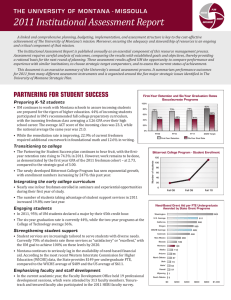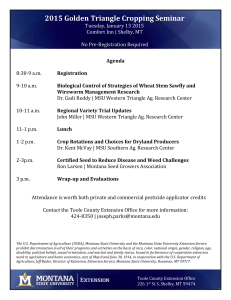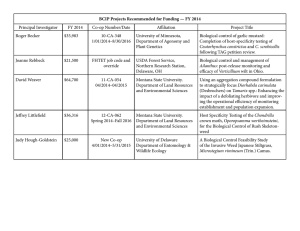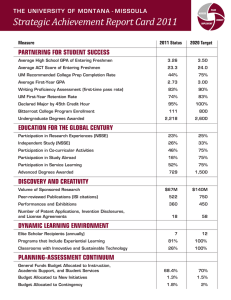2012 Institutional Assessment Report UM 2020: Building a University for the Global Century
advertisement
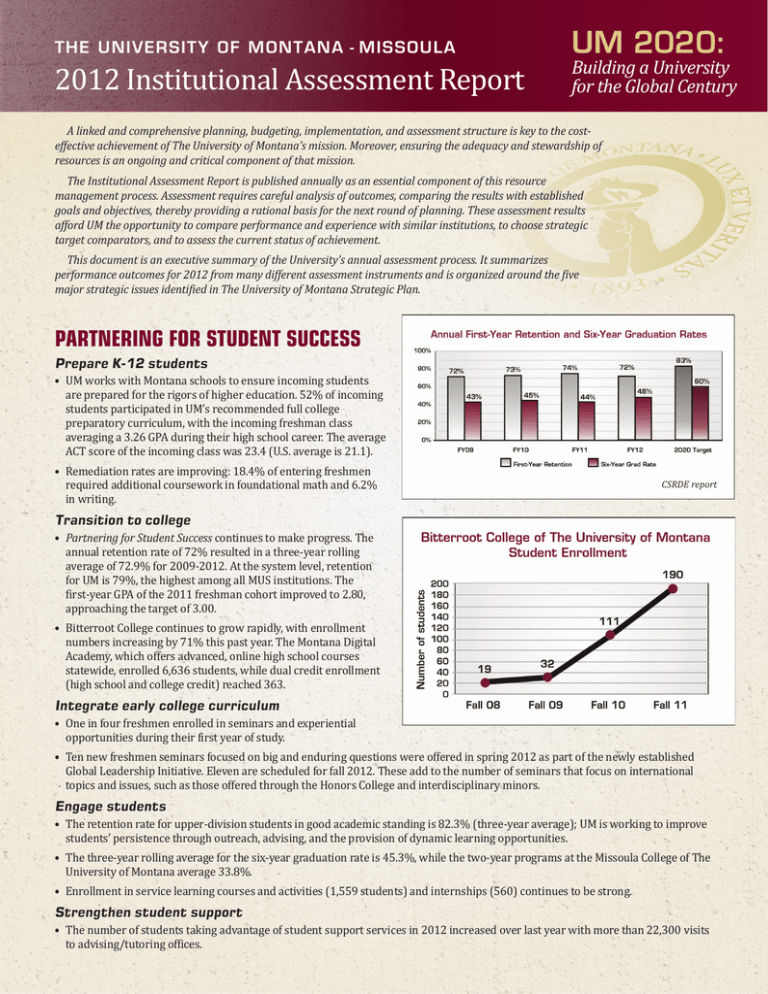
T H E U NIVER S I TY O F MO N TA N A - M I S S OUL A 2012 Institutional Assessment Report UM 2020: Building a University for the Global Century A linked and comprehensive planning, budgeting, implementation, and assessment structure is key to the costeffective achievement of The University of Montana’s mission. Moreover, ensuring the adequacy and stewardship of resources is an ongoing and critical component of that mission. The Institutional Assessment Report is published annually as an essential component of this resource management process. Assessment requires careful analysis of outcomes, comparing the results with established goals and objectives, thereby providing a rational basis for the next round of planning. These assessment results afford UM the opportunity to compare performance and experience with similar institutions, to choose strategic target comparators, and to assess the current status of achievement. This document is an executive summary of the University’s annual assessment process. It summarizes performance outcomes for 2012 from many different assessment instruments and is organized around the five major strategic issues identified in The University of Montana Strategic Plan. PARTNERING FOR STUDENT SUCCESS Prepare K-12 students • UM works with Montana schools to ensure incoming students are prepared for the rigors of higher education. 52% of incoming students participated in UM’s recommended full college preparatory curriculum, with the incoming freshman class averaging a 3.26 GPA during their high school career. The average ACT score of the incoming class was 23.4 (U.S. average is 21.1). • Remediation rates are improving: 18.4% of entering freshmen required additional coursework in foundational math and 6.2% in writing. CSRDE report Transition to college • Partnering for Student Success continues to make progress. The annual retention rate of 72% resulted in a three-year rolling average of 72.9% for 2009-2012. At the system level, retention for UM is 79%, the highest among all MUS institutions. The first-year GPA of the 2011 freshman cohort improved to 2.80, approaching the target of 3.00. • Bitterroot College continues to grow rapidly, with enrollment numbers increasing by 71% this past year. The Montana Digital Academy, which offers advanced, online high school courses statewide, enrolled 6,636 students, while dual credit enrollment (high school and college credit) reached 363. Integrate early college curriculum • One in four freshmen enrolled in seminars and experiential opportunities during their first year of study. • Ten new freshmen seminars focused on big and enduring questions were offered in spring 2012 as part of the newly established Global Leadership Initiative. Eleven are scheduled for fall 2012. These add to the number of seminars that focus on international topics and issues, such as those offered through the Honors College and interdisciplinary minors. Engage students • The retention rate for upper-division students in good academic standing is 82.3% (three-year average); UM is working to improve students’ persistence through outreach, advising, and the provision of dynamic learning opportunities. • The three-year rolling average for the six-year graduation rate is 45.3%, while the two-year programs at the Missoula College of The University of Montana average 33.8%. • Enrollment in service learning courses and activities (1,559 students) and internships (560) continues to be strong. Strengthen student support • The number of students taking advantage of student support services in 2012 increased over last year with more than 22,300 visits to advising/tutoring offices. • Montana falls behind other states in the availability of need-based financial aid. The most recent Western Interstate Commission for Higher Education (WICHE) data show Montana providing $105 per undergraduate FTE, compared to the WICHE average of $486 and the US average of $488. Emphasize faculty and staff development • The Faculty Development Office held 23 professional development sessions, attended by 366 faculty. • HERI faculty survey data show UM faculty are more involved in community service than their peers (68.1% versus 50.1%). • A Training/Development Officer was hired to create, promote, and implement effective training and development programs for staff and others in the campus community. • Awards granted on UM Employee Recognition Day totaled $19,500 for staff and administrators who demonstrated exemplary service. EDUCATION FOR THE GLOBAL CENTURY Strengthen foundational academic programs • Academic programs conduct annual assessments and are evaluated on a seven-year cycle. Programs are assessed against program-specific learning outcomes with results published online. More than 30 programs are nationally accredited. Two-year programming responsive to local, regional, state, and national needs • Missoula College continues to offer outstanding instruction. Students in the Energy Technology Program participated in the national Shell Eco-marathon with a student-constructed solar vehicle. All graduates of this program have obtained employment or are continuing their education. • A new associate’s degree in Police Science was approved in 2012 to provide a pathway for police officers seeking additional higher education. Global engagement and leadership at all levels • The Global Leadership Initiative (GLI) was launched in 2011. The GLI models a framework that encourages students to contemplate their overall education and focus on significant interdisciplinary questions and challenges faced by people in our global society. • UM ranks 14th among medium-sized universities in Peace Corps volunteers. A new Peace Corps prep program is among only three in the nation, and the only one at a public university. Discovery and innovation through graduate education • The number of graduate degrees awarded continues to rise, with 775 students earning master, professional, and doctoral credentials in 2012. • The addition of new graduate programs, such as one in Systems Ecology, will allow further growth. DISCOVERY AND CREATIVITY TO SERVE MONTANA AND THE WORLD Enhance contributions by faculty and students through research • Faculty and student discovery led to 10 patent applications, 10 invention disclosures, and five license agreements this year. • The Center for Biomolecular Structure and Dynamics (CBSD) at UM received a five-year, $9.9 million, Center of Biomedical Research Excellence (CoBRE) award from the National Institutes of Health to investigate physiological processes and diseases from the standpoint of atomic structure, chemistry and physics. Expand knowledge and cultural richness through creative scholarship • UM faculty and students were responsible for 370 visual and performing arts exhibitions in 2012, and 598 publications of scholarly articles (ISI citations). • The American College Dance Festival Association chose the UM Dance Program to perform at the National College Dance Festival held at the John F. Kennedy Center for the Performing Arts in Washington, D.C. Advance today’s discoveries to tomorrow’s products through technology transfer, contributing to the creation of innovations, jobs, and business opportunities. • The volume of extramurally funded research activity was $64 million in 2012. • UM research activity is a catalyst for economic activity, producing nearly 700 high-paying jobs. DYNAMIC LEARNING ENVIRONMENT People – Lead in recruiting, retaining, and developing the highest quality students, faculty, and staff • UM faculty continue to publish research reports, technical comments, and invited commentary in top-tier journals, including nine such contributions in Science and Nature over the past year. • UM junior Zach Brown is a 2011 and 2012 Udall Scholar, as well as a Truman Scholar. • UM had eight Fulbright student awardees this year. • Alumna Ashleen Williams, one of UM’s 2011 Fulbright Fellows, was awarded a Mitchell Fellowship for study in Ireland in 2012. • UM senior Ben Murphy was the winner of the National-MTNA Young Artist Composition Competition. Programs – Provide programs of distinction, engaging local to world-wide partnerships, connecting programs to our unique locations • UM added a Systems Ecology program (M.S., Ph.D.), an Athletic Training Masters degree, a minor in Arabic Studies, a minor in Fire Science and Management, a minor in Global Public Health, and an associate’s degree in Police Science. Analysis of Clark Fork River sediment (Dr. A. Wilcox and geosciences student) • Online student credit hours have increased 254% over the past 5 years. Infrastructure – Utilize technologies and practices that optimize the learning experience while modeling sustainability • In financial partnership with the UM Foundation and approved by the Associated Students of UM, the Gilkey Executive Education Center will be constructed, adding 31,000 additional square feet for classrooms and offices. In accordance with UM standards, this building will meet or exceed LEED Silver status. • In 2011 UM initiated the bound books recycling program in addition to delivering 666,930 lbs of materials to recycling centers, including 6,360 lbs of fluorescent lamps, 72,300 lbs of electronic waste, and 588,270 lbs of recyclable materials. Culture – Inspire an atmosphere where engagement and passion for learning thrive • Students at UM have opportunities to attend and participate in hundreds of lectures, conferences, performances, and exhibits. They can join any of more than 180 student groups supported by the Associated Students of The University of Montana. Place – Integrate the character of the campus environment into discovery and instruction • Students participate in the local community through outreach, cultural events, and open access to learning opportunities. In recognition, the Carnegie Foundation highlights UM as an institution of higher learning that shows “Curricular Engagement and Outreach Partnerships.” The Princeton Review included UM in the “Guide to 322 Green Colleges” (2012 edition). • The new Crown of the Continent initiative offers an opportunity to research, explore, and learn about all aspects of a dynamic mountain ecosystem. Lessons learned can be exported to other parts of the nation and the world. PLANNING-ASSESSMENT CONTINUUM Link plans and resources • The UM Strategic Plan, published in spring 2011, was developed through a collaborative effort that included input from diverse constituents across campus. Closely linked with the new NWCCU accreditation process, it sets the strategic direction that will shape the University for the remainder of the decade, beginning with the current evaluation cycle. The plan includes performance indicators by which progress toward mission achievement will be measured. • The Planning-Assessment Continuum is an integrated resource management structure that aligns institutional processes to ensure that resources are strategically shepherded to facilitate the accomplishment of strategic goals. • The combined endowment value for The University of Montana and The University of Montana Foundation was $123,306,669. • The University has committed 68.5% of FY13 general funds toward instruction, academic support, and student services – up from 68.4% in FY12. The 2020 strategic goal is 70%. Transparent and participative processes throughout the cycle • Faculty, staff, students, academic and executive leaders, alumni, and community members directly contributed, and will continue to contribute, to the Planning-Assessment Continuum. • 100% of UM’s strategic and operating plans are published and available online. Annual assessment reports and budget allocations are also published and available to the campus and the community. • In spring 2012, the University Budget Committee utilized the Strategic Plan to develop budget recommendations, and these recommendations were presented to the Council of Vice Presidents, with final approval by the President. Data-driven decisions and goal-setting • Structured to parallel the Strategic Plan, this Institutional Assessment Report, along with the more detailed assessment data upon which it is based, forms the core of the President’s annual State of the University Address at the beginning of the new academic year. • The University Planning Committee will update the Strategic Plan in fall 2012 to reflect the current assessment data, and will refine the planning priorities for the upcoming biennium. Objective and timely assessment of outcomes • The Institutional Assessment Reports, including the UM Report Card, are published at the conclusion of each fiscal year. UM 2020: Building a University for the Global Century Printed on recycled paper with eco-friendly inks
